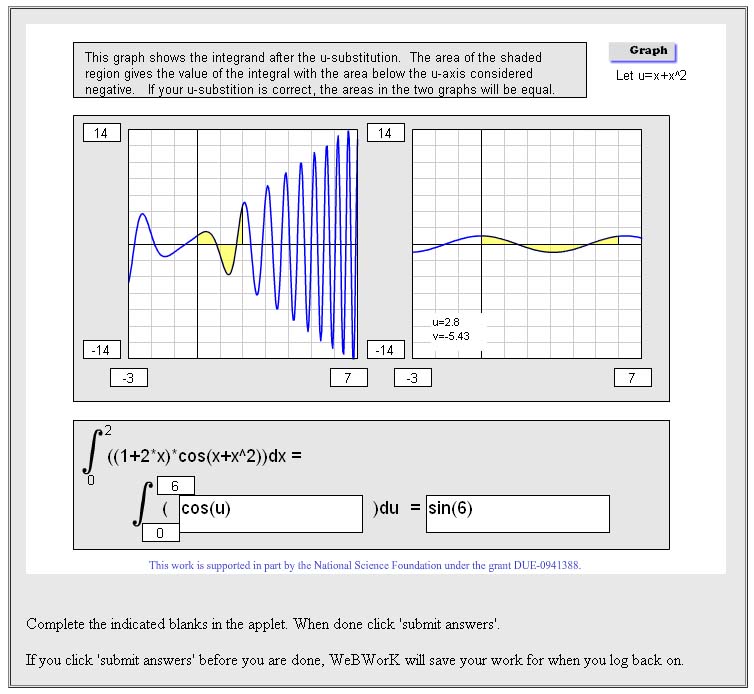USub Applet Sample Problem
Flash Applets embedded in WeBWorK questions u-subsitution Example
Sample Problem with uSub.swf embedded
This sample problem shows how to use the u-substitution applet.
This applet and WeBWorK problem are based upon work supported by the National Science Foundation under Grant Number DUE-0941388.
Click here to see a problem like this in action: testcourses.webwork.maa.org/webwork2/FlashAppletDemos

A standard WeBWorK PG file with an embedded applet has six sections:
- A tagging and description section, that describes the problem for future users and authors,
- An initialization section, that loads required macros for the problem,
- A problem set-up section that sets variables specific to the problem,
- An Applet link section that inserts the applet and configures it, (this section is not present in WeBWorK problems without an embedded applet)
- A text section, that gives the text that is shown to the student, and
- An answer and solution section, that specifies how the answer(s) to the problem is(are) marked for correctness, and gives a solution that may be shown to the student after the problem set is complete.
The sample file attached to this page shows this; below the file is shown to the left, with a second column on its right that explains the different parts of the problem that are indicated above. A screenshot of the applet embedded in this WeBWorK problem is shown above.
Other applet sample problems:
GraphLimit Flash Applet Sample Problem
GraphLimit Flash Applet Sample Problem 2
Derivative Graph Matching Flash Applet Sample Problem
Hint Applet (Trigonometric Substitution) Sample Problem
| PG problem file | Explanation |
|---|---|
##DESCRIPTION
## Integration with substitution
##ENDDESCRIPTION
##KEYWORDS('integral', 'substitution')
## DBsubject('Calculus')
## DBchapter('Integration')
## DBsection('Integration with substitution')
## Date('6/9/2011')
## Author('Barbara Margolius')
## Institution('Cleveland State University')
## TitleText1('')
## EditionText1('2011')
## AuthorText1('')
## Section1('')
## Problem1('')
########################################
# This work is supported in part by the
# National Science Foundation
# under the grant DUE-0941388.
########################################
|
This is the tagging and description section of the problem. Note that any line that begins with a "#" character is a comment for other authors who read the problem, and is not interpreted by WeBWorK. The description is provided to give a quick summary of the problem so that someone reading it later knows what it does without having to read through all of the problem code. All of the tagging information exists to allow the problem to be easily indexed. Because this is a sample problem there isn't a textbook per se, and we've used some default tagging values. There is an on-line list of current chapter and section names and a similar list of keywords. The list of keywords should be comma separated and quoted (e.g., KEYWORDS('calculus','derivatives')). |
DOCUMENT(); loadMacros( "PGbasicmacros.pl", "extraAnswerEvaluators.pl", "AppletObjects.pl", ); |
This is the initialization section of the problem. The first executed line of the problem must be the
The |
# Set up problem
TEXT(beginproblem());
$showPartialCorrectAnswers = 1;
Context("Numeric");
Context()->variables->add(u=>"Real");
$b = random(1,2,1);
$ubig = Compute("$b+$b^2")+random(1,2,1);
$vbig = Compute("2+2*($b+$b^2)");
$vsmall = -$vbig;
$anslist = List(
Compute("cos(u)"),
Compute("0"),
Compute("$b+$b^2"),
Compute("sin($b+$b^2)"));
|
This is the problem set-up section of the problem.
The uSub.swf applet has the student enter a four part solution: the integrand after the u-substitution, the lower limit of integration in terms of u, the upper limit of integration in terms of u, and the value of the integral. The correct answer must be entered in list format in the pg file. That is what the code |
###################################
# Create link to applet
###################################
$appletName = "uSub";
$applet = FlashApplet(
codebase
=> findAppletCodebase("$appletName.swf"),
appletName => $appletName,
appletId => $appletName,
setStateAlias => 'setXML',
getStateAlias => 'getXML',
setConfigAlias => 'setConfig',
maxInitializationAttempts => 5,
answerBoxAlias => 'answerBox',
height => '550',
width => '700',
bgcolor => '#e8e8e8',
debugMode => 0,
submitActionScript =>
qq{getQE("answerBox").value
=getApplet("$appletName").getAnswer() },
);
###################################
# Configure applet
###################################
#initially the answers will be blank
$applet->configuration(qq{<xml>
<plot func='(1+2*x)*cos(x+x^2)'
lower='0' upper='$b'/>
<grids xgrid='1' ygrid='$b'/>
<win xmin='-3' xmax='$ubig'
ymin='$vsmall' ymax='$vbig'
umin='-3' umax='$ubig'
vmin='$vsmall' vmax='$vbig' />
<ans func='' lower='' upper =''
theValue='' />
<usub ufunc='x+x^2'/></xml>});
#initially the answers will be blank
$applet->initialState(qq{<xml>
<plot func='(1+2*x)*cos(x+x^2)'
lower='0' upper='$b'/>
<grids xgrid='1' ygrid='$b'/>
<win xmin='-3' xmax='$ubig'
ymin='$vsmall' ymax='$vbig'
umin='-3' umax='$ubig'
vmin='$vsmall' vmax='$vbig' />
<ans func='' lower='' upper =''
theValue='' />
<usub ufunc='x+x^2'/></xml>});
TEXT( MODES(TeX=>'object code',
HTML=>$applet->insertAll(
debug=>0,
includeAnswerBox=>1,
)));
|
This is the Applet link section of the problem.
Those portions of the code that begin the line with You must include the section that follows The lines The code
When the submit button is pressed, the hidden form fields defined in this block are filled with information from the applet. |
TEXT(MODES(TeX=>"", HTML=><<'END_TEXT'));
<script>
if (navigator.appVersion.indexOf("MSIE") > 0) {
document.write("<div width='3in'
align='center' style='background:yellow'>
You seem to be using Internet Explorer.
<br/>It is recommended that another
browser be used to view this page.</div>");
}
</script>
END_TEXT
|
The text between the |
BEGIN_TEXT $BR $BR Complete the indicated blanks in the applet. When done click 'submit answers'. $PAR If you click 'submit answers' before you are done, WeBWorK will save your work for when you log back on. END_TEXT Context()->normalStrings; |
This is the text section of the problem. The Answers are submitted within the applet, so no answer blanks are provided here. The parser in the applet is not as sophisticated as the WeBWorK parser so '*' must explicitly be entered for times in order for the function to graph within the applet. The answers are graded by WeBWorK so a correctly formulated WeBWorK answer will be marked as correct, but may not be graphable. |
################################### # # Answers # ## answer evaluators NAMED_ANS( 'answerBox'=>$anslist-> cmp(ordered=>1) ); ENDDOCUMENT(); |
This is the answer section of the problem. The problem answer is recorded in the applet. The code
The |
License
The Flash applets developed under DUE-0941388 are protected under the following license: Creative Commons Attribution-NonCommercial 3.0 Unported License.